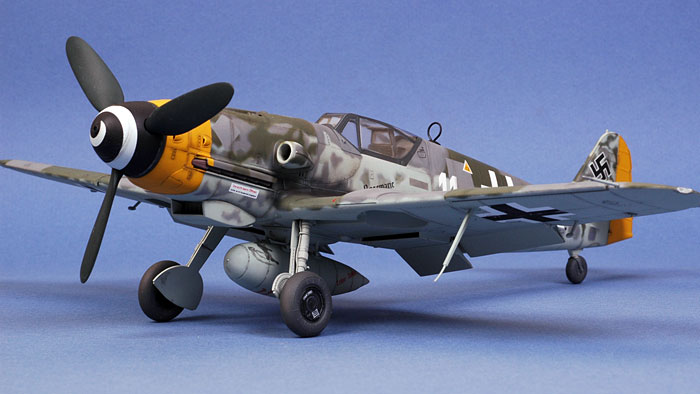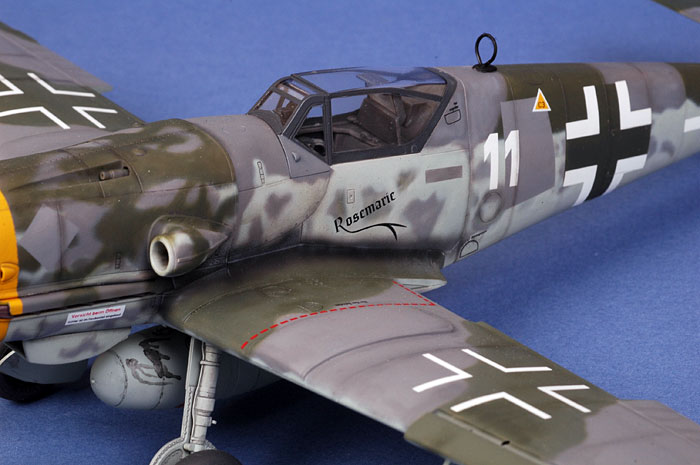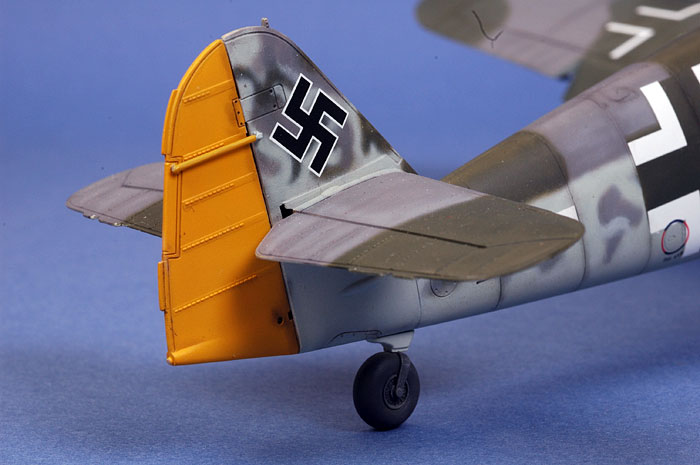|
Hasegawa's 1/32 scale Bf 109 G-10
Decisions, Decisions
by Mike Robertson

|
Messerschmitt Bf 109 G-10/U4
White 11, “Rosemarie”, II/JG52 |

Hasegawa's 1/32 scale Bf 109 G-10 is availale online from Squadron.com
When Hasegawa released their excellent 1/32 scale Bf 109’s, I purchased both the G10 and K4 versions as they offered the opportunity to model these pugnacious looking developments of the sleek 109 F airframe in late war colours and markings.
In collecting various references to complete the build of this 109-G10, the variations of scheme interpretation of this particular aircraft in the references left me with a number of decisions to make.
The references include Green (2000), Janda & Poruba (2004) and Janowicz (2006). I suspect that there are other References available that also feature this particular aircraft.
The kit was built out of the box with only the gun barrels drilled out.
HyperScale features a number detailed builds of the Hasegawa 109 kits so I’ll only mention my few issues. Suffice to say, it went together beautifully with only minor filling required where the centre wing attachment joined the fuselage and, where the forward and aft fuselage components meet. The nose cowl required some jinking for a good fit.

The keen eyed will notice that I managed to mount the rudder trim tab actuator link on back to front (bugger!!!!).
Filling was completed with Tamiya putty and, Testors liquid cement used for construction.
The kit was painted with Xtra colour, Humbrol and Tamiya enamels using a Badger 200 airbrush.
The kit was sprayed with Humbrol Matt White as an undercoat to highlight flaws and provide a base colour for the Yellow cowl band and rudder.
Humbrol Matt Trainer Yellow was applied as base for the final coat for the Xtra Colour Yellow. These areas were then masked and then each of the main camouflage colours was applied freehand with the colours lightened with white.
Overspraying of the main camouflage colours was then carried out with darkened tones of each of the colours until the desired effect was achieved. The cowl was the painted following masking of the areas around it to achieve the different finish seen in the photos. Finally, the painted out previous unit markings were then applied to reflect the appearance in the photos.

Micro Set and Sol were used in decal application before a light application of thinned dark grey was applied as a wash to highlight various panels.
A light spray of Tamiya Smoke was then airbrushed to again highlight specific areas. Finally, Xtra Colour Flat was applied to complete the kit.
“Decisions, decisions”
When Eagle Cals released their 109 sheet EC #81, it featured this aircraft in a scheme probably reflecting the late war chaos that the Lutwaffe operated in re paint availability and/or camouflage considerations. The aircraft is identified by all authors as a Bf 109 G-10 of II/JG52 at Neubiberg airfield in 1945.
Now it gets interesting and Table 1 below displays the variations in interpretation by the authors.
|
Green (2000) |
Janda & Poruba (2004) |
Janowicz (2006) |
Upper
Fuselage |
75/83 or 77 or mixed grey |
75/83 |
74/75 |
Upper
Wings |
75/83 |
75/83 |
74/75 |
Underside |
76 |
76 |
76 |
“Rosemarie” |
Black |
Red/Black trim |
Red/Black trim |
Cowl Band
Location
Colour |
Central
Yellow
|
Forward
Yellow
|
Forward
Yellow
|
Cowl |
75/83 |
75/83 |
74/75 |
Rudder |
Yellow |
Yellow |
Yellow |
Antenna Mast |
Featured
(profile) |
Not
Featured
(profile) |
Not
Featured
(profile) |
Table 1: Author variations
It can be seen that there are variations in interpretation of the scheme by the authors and whilst Green (2000) and Janda & Poruba (2004) offer considerable discussion of their interpretations, Janowicz (2006) limits the discussion to the profile text in the profile pages at the rear of the book.
I elected to follow Janda & Poruba’s (2004) interpretation at the time of my build. Specific points with respect to my build are as follows:
“Rosemarie”
The close up photos on page 41 of Janda & Poruba (2004) and page 12 of Janowicz (2006) seem to show two distinct colours to the name. A lighter colour shadowed with a darker trim which I accepted as the Red/Black interpretation of Janda & Poruba (2004) and Janowicz (2006). In the photo’s of my kit, note that I have used the “Rosemarie” as supplied by the Eagle Cal sheet as my skills with a paint brush don’t extend to such delicate work.
Cowl Band Location
Careful examination of the photos on page 25 of Green (2000) and page 39 of Janda & Poruba (2004) indicates camouflage mottling and, the painting out of the previous Unit marking on the cowl identified by Janda & Poruba (2004, p.69) as II/JG51, around the centre of the cowl and a uniform colour around the forward area of the cowl hence my decision to run with the Yellow band being located at the forward location. Additionally, I replicated the painted out unit marking as identified by Janda & Poruba (2004, p.69) and also shown in the profile in Janowicz (2006).
Upper camouflage colours
This was the most vexing issue for me. Certainly, the photos on page 25 (Green, 2000) and page 39 Janda & Poruba (2004) show the aircraft featured a very patchy, light fuselage camouflage scheme, particularly in light of the evidently darker cowl colours. I based my decision to run with 75/83 based on the discussion of the WNF factory camouflage colour application style by Janda & Poruba (2004, pp.23-28) who further, identify this aircraft as a WNF produced aircraft. That said, on reflection I now tend towards Green’s (2000, p.25) interpretation of the colours after endless hours looking at the photos identified. An interesting point for consideration however, the photos on page 41 (Janda & Poruba, 2004) appear to show darker colours in general and complicate the issue.

Further, these photos on page 41 of Janda & Poruba (2004) show that the aircraft featured a very muddy and stained appearance aft of the wing. Also, what appears to be a painted out Gruppe marking, shown in the profiles in Green (2000, p.33), Janda & Poruba (2004, p.68) and Janowicz (2006), may be seen in the page 41 photo (Janda & Poruba, 2004) in addition to the painted out previous aircraft side number evident in all references noted. Additionally, the photos in Green (2000, p.25) and Janda & Poruba (2004, p.39) seem to show/suggest that the upper wings were in the similar light colours of the fuselage.
Antenna Mast
Janda & Poruba (2004,) and Janowicz (2006) profile this aircraft without an antenna mast whilst Green (2000) does. The photo on page 41 (Janda & Poruba, 2004) confirms the antenna wire attaches to the fuselage aft of the canopy through the DF loop. Certainly, many photos in (Janda & Poruba, 2004) illustrate Bf109-G10’s without the antenna mast. However, none of the photos of “Rosemarie” show the antenna mast but it must be noted that where the canopy is shown, it is open and if the mast is integral with the canopy it is not possible to determine if it is there. I elected to leave it off.
This article reflects my journey through the build of an intriguing Bf 109 G-10 using the References noted.
I am extremely grateful to all the authors mentioned, and the many others, who produce publications that enable us as modellers to build kits with the accuracy that in years past was not possible. In particular, the work of the profile artists featured Tullis (Green, 2000), Poruba and Farkas (Janda & Poruba, 2004) and Wrobel (Janowicz, 2006) is just inspiring.
It is my intention on reflection to revisit this particular Bf109 in a new build better amalgamating the information available to produce a partner for my first effort. Of interest, Brett Green recently reprised his build on Hyperscale of the 1/48 Hasegawa Bf 109 G-10/U4 discussed with additional information on paint patch work, particularly around the lower aft fuselage.
Until then, it is back to my 1/32 Matchbox Sea Venom project now in it’s 14 month.
Cheers, Robbo (Mike Robertson).
Green, B. (2000). Eagle Files, EF#3. Augsburg’s Last Eagles: Colors, Markings and Variants. Eagle Editions Ltd. Hamilton, MT. USA.
Janda,A., & Poruba, T. (2004). Luftwaffe Over Czech Territory – 1943: Messerschmitt Bf 109G-10/U4: Production & Operational Service. JaPo.Hradec Kralove, Czech Republic.
Janowicz, K. (2006). Messerschmitt Bf 109 G/K Vol III. Kagero. Lublin, Poland.
Model and
Text Copyright © 2008 by Mike Robertson
Images Copyright © 2008 by Brett Green
Page Created 18 February, 2008
Last Updated 18 February, 2008
Back to HyperScale
Main Page |
Home
| What's New |
Features |
Gallery |
Reviews |
Reference |
Forum |
Search